Lures are expensive. Fish live in snags. We all know what that means, don’t we?
Catching fish on lures is about as much fun as you can have with your pants on (or off, as you will find out about later). However, if there is one thing guaranteed to take all the enjoyment out of the whole lure fishing experience, it’s getting snagged and losing your valuable artificials.
Unfortunately, there really is no way to avoid getting snagged from time to time because if you want to catch fish, you have to put your lures where the fish live. In general, that’s right in amongst the snags. In fact, most experienced anglers know that if you aren’t getting snagged occasionally, you probably aren’t putting your lures in the strike zone and are potentially costing yourself hook-ups.
Seeing as snags are a fact of life, what can you do to minimise the hang-ups and maximize your lure recovery rate? Well, the first mistake I see most inexperienced anglers make when they get snagged is to clamp down on the spool and try to pull the lure off. While this does work some of the time, in the vast majority of cases all it does is drive the hooks further into the snag and make it even harder to get your lure back. Instead of clamping down, you need to do the opposite and give your lure a little bit of slack line. Provided the hooks haven’t already been dug in, a bit of slack will often be enough to allow the lure to float up and over the offending snag.
If that doesn’t work, what’s next? Well, the next move is to back up past the snag and try to gently pull the lure off. If you can pull from the opposite direction, you will often find the lure is easy to remove. Failing that, another technique worth trying is what could be called the Jackal shake, which is a technique anglers have developed for shaking sinking lures out of the snags. All it involves is short, rapid-fire flicks of the rod tip to literally shake the lure out of the woodwork.
The first time I saw this technique used was during an ABT BASS competition at Lake Monduran, when I was lucky enough to fish with Tim ‘The Bream’ Morgan. More times than not, Tim was able to shake his Jackals out of the timber without needing to muck around with a lure retriever. This not only saved his lures but, more importantly during a comp, saved his valuable fishing time and helped him to finish in the money.
OK, you’ve tried all that and you are still snagged. What next? Well, at this point in time you are going to need a lure retriever.
There are two types of lure retrievers you can go with, a weight on a cord or a push pole. Having used both types extensively, I can say I do favour pole type retrievers for a lot of situations but both have their advantages and disadvantages.
Let’s look at the cord type first. You have a couple of choices as to the actual construction of the cord retriever and the retrieval method to use. The most basic and certainly the first type I ever used is the Tackleback. Tacklebacks have a lead body with a diamond-shaped wire loop on the end. To use it, you simply open up the wire, slip it over your line and let it slide it down the line until the tip of the diamond loop lodges over the clip or snap swivel. It can work quite well, but to be really effective you do need to attach your lure with a snap of some kind for the Tackleback to grip onto.
The next type of retriever has chains, loops or other tangling devices in place of the wire. I have a SNAHU (which stands for: Situation Normal, All Hung Up) that has chains hanging off the bottom of it, and a Bandit Lure Retriever which has two stainless wire loops. Both of them work quite well, as long as there is not too much current (or wind) about. For this type of retriever, you really do need to be pretty much directly over the top of the lure to make the retrieval process effective. Unless you have a super heavy-duty model, I have found that these types of retrievers are much less effective in strong currents, although the Bandit is the more effective of my pair as it is significantly heavier.
The final type of lure retriever is a push pole. I use a StrikeBack lure retriever and it is effective in most situations, at least in water up to about 6m deep – or conversely, on lures snagged in trees up to 6m up in the air! Not that an experienced lure caster like me would ever have to use it for that sort of purpose – yeah right!
The StrikeBack consists of a thick wire pigtail on the end of a multi-section fibreglass (or graphite) pole. The pole sections come in 1.5 metre lengths and can be easily screwed together to make up the desired length. You can buy as many poles as you think you will need, and I have heard of blokes using them up to 9m long.
One of the biggest disadvantages of the pole type retriever is that they are very unwieldy in a small boat. If you are consistently using more than three sections, it can be a bit of a pain to control, especially if you are fishing solo. Unfortunately, the poles also have a habit of being dropped overboard! My original one went swimming twice. The first time was in reasonably clear and shallow water and the bloke who dropped it overboard dived in and got it back. The second time was in Monduran Dam where I lent it to a couple of young blokes who were trying to get their lure un-snagged. Unfortunately they dropped four sections of it over the side and we were unable to recover it. It was an expensive splash and I don’t think I will be so quick to loan my new one to anybody.
When it comes to the actual retrieval process, in calm conditions it is usually easy enough to manage on your own. When things get windy, or the current is running hard, it really becomes a two-person task. In these situations, good teamwork is all-important.
In fact, for really successful lure recovery, I reckon three is a good number. That way, there is one to drive the boat, one to control the line and a third person to use the retriever. I know that sounds like overkill but I do take the whole concept of getting my lures back very seriously! Case in point: I once stripped to my bright red jocks and dived into the near-freezing head waters of Talbingo Dam to try to recover one of my favourite lures. It was the middle of winter in the Snowy Mountains and it was raining (possibly snowing) at the time.
It was a bad move. The water was so cold, it sucked all the air out of my lungs and if I hadn’t managed to desperately grab onto the side of the boat with one hand as I jumped in, I probably would have sunk straight to the bottom and drowned. It’s probably as close to dying as I have ever been – my whole life flashed before my eyes!
After an experience like that, is it any wonder I never head out fishing without at least a couple of lure retrievers?
Facts
CORD TYPE LURE RETRIEVERS
Pros:
• Easy to store and transport.
• Relatively easy to use single handed
• Effective depth limited only by length of cord
• Quick to set up
• Inexpensive
• Moderate to high ratio of lures successfully retrieved
Cons:
• Cord prone to tangling
• Works well only when virtually right over the lure
• Some types work only when the lure is attached with a snap clip
• Can only pull, not push lures free
Facts
POLE TYPE LURE RETRIEVERS
Pros:
• Cope better with strong currents than cord type retrievers
• Don’t need snaps or clips to grab the lure
• Can be used to ‘push’ lures off snags
• Can be used on lures snagged up in trees
• Very high ratio of lures successfully retrieved
Cons:
• Takes up a lot of room in a small boat
• Awkward to use single handed
• Prone to being dropped overboard
• Effective depth limited to length of pole
• More expensive than cord type retrievers
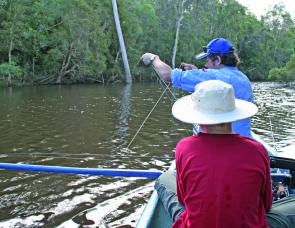
Here’s a disaster waiting to happen. Never grab the rod tip when trying to un-snag a lure.
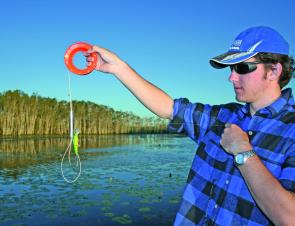
Most cord type retrievers use wire loops or chains to ensnare the lure’s hooks, and are relatively easy to use single handed.
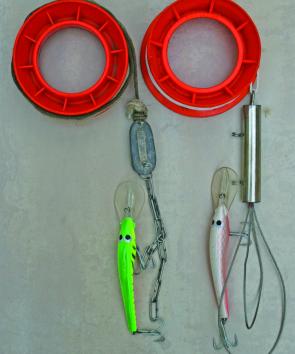
Most cord type retrievers use wire loops or chains to grab the lure’s hooks.
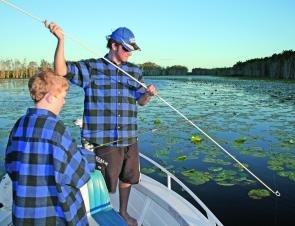
Pole type retrievers really need two people to use them effectively.
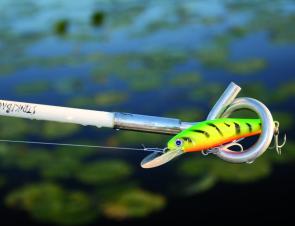
One advantage of pole type retrievers is that they can ‘push’ lures off snags.

When you fish this sort of snaggy country, you had better have a good lure retriever.

Species that live close to structure like cod demand that you have some form of lure retriever on board, otherwise fish like this cod caught by Phill Jones may not be landed on your favourite lure.






